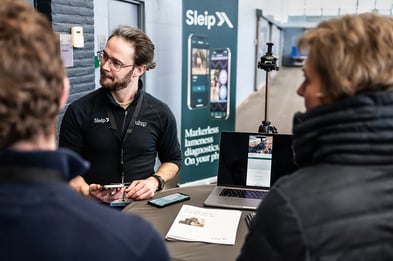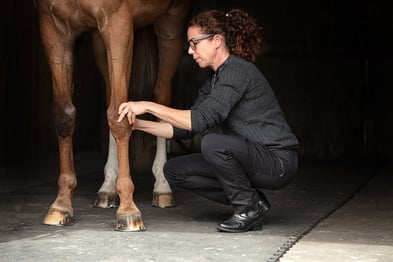Sleip renews sponsorship for EGAS Live Course in 2026
Sleip will continue its sponsorship of the EGAS Live Course 2026 — marking our 4 year supporting advanced post-graduate education in quantitative gait analysis for equine veterinarians.

New technology makes it possible to measure asymmetries in a horse’s movement with a mobile phone. Does that mean we don’t need vets when it comes to lameness assessments? - No, is researcher Elin Hernlund's answer, a lameness assessment is much more complex than that.
Translated summary of article:
Various forms of technology have been used to measure the horse's movement patterns for several years now. There is everything from markers in the form of reflective balls to small "measuring boxes" attached to specific points on the horse's body.
Now you can also use artificial intelligence (AI), capable of making the assessment from an ordinary mobile phone recording with the help of so-called artificial neural networks.
Lameness is measured by monitoring specific points on the horse's body, head, withers, rump. It shows how the horse loads and pushes off with each leg.
- The AI measurements provide extremely precise data and the technology can detect a small limp long before the human eye can perceive it, says Elin Hernlund, one of Sweden's leading researchers in the field.
But making a lameness assessment involves much more than just perceiving precise movement patterns. It is a collaboration between veterinarian and rider.
- If it is about subtle lameness, the most important thing is to see how the horse functions over time. You shouldn't be too afraid of a small movement asymmetry. But it is important to understand if the horse deteriorates if it the training load is increased.
- My colleague Marie Rhodin did a project in which 220 horses that were trained and competed regularly participated. All were well functioning. Nevertheless, 73% of those horses were found to have a movement asymmetry. It shows that AI can't put the whole puzzle together when it comes to lameness. You cannot rely solely on technology - then most horses would look lame.
So what are we going to do with artificial technology when it comes to lameness assessments in the future?
- AI makes it possible to detect lameness measurements from regular video. This means that measurement technology will be available to everyone! The horse owner can film his horse at home with the mobile phone as part of a rehabilitation program and as a way to see changes in movement over time. In this way, we can adapt the rehabilitation and training plan in a precise way for each individual horse.
Will every rider have an app in their phone that can measure movement disorders in the future?
- Yes, I absolutely think so. Now I'm extremely nerdy but I think those who are ambitious riders will be interested in measuring the horse over time. It's the best we can do to prevent lameness!
To the article (Swedish)

Sleip will continue its sponsorship of the EGAS Live Course 2026 — marking our 4 year supporting advanced post-graduate education in quantitative gait analysis for equine veterinarians.

SLU, Sleip, and a number of private equine clinics have collaborated on a study showing how anatomical size-scaling helps align objective gait data with visual lameness assessments

This summer we conducted a survey about equine lameness for more than 100 equine veterinarians from the ISELP community.